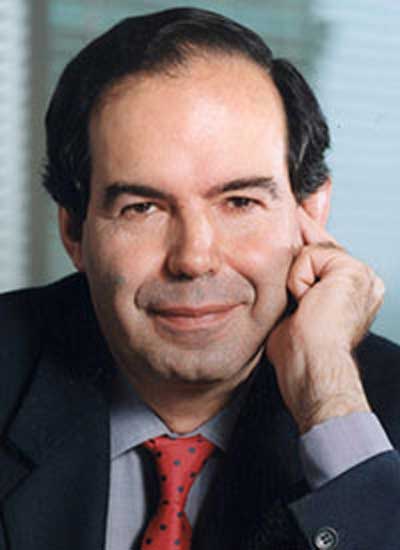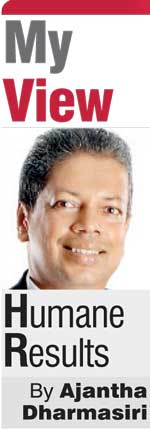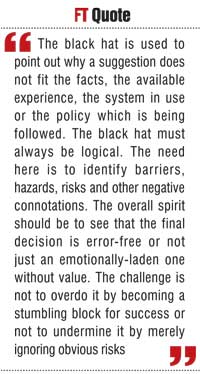Sunday Apr 20, 2025
Sunday Apr 20, 2025
Monday, 13 July 2015 00:00 - - {{hitsCtrl.values.hits}}


Decision-making is a delicate part of a managerial career. This is true of Human Resource professionals as well. Thinking is the central theme when it comes to decisions. Today’s column is all about how HR professionals can play six thinking roles, based on six thinking hats developed by Dr. Edward de Bono, in the early ’80s.
Dr. de Bono, in his book ‘Six Thinking Hats’, discusses an important and powerful technique that is used to look at decisions from a number of important perspectives. This forces us to move outside our habitual thinking pattern and helps us to get a more rounded view of a situation.
As we discussed in a previous column, an HR professional can be viewed as a senior person engaged in Human Resources activities as an occupation.
In other words, he is a manager with experience and qualifications, handling the responsibilities associated with the Human Resources function within an organisation. HR professionals are responsible for attracting, engaging, developing, rewarding and retaining the most precious resource of any organisation, i.e. its human resource. In this endeavour, they need to demonstrate the ability to think big. Let’s draw parallels to the roles they should play in line with the six thinking hats of Edward de Bono.
In a nutshell, I would call them the six Ps: prober, partner, preventer, provider, proposer and planner.
HR professional as a prober
When he/she wears the white hat, the role in focus is what I would like to call the prober. According to de Bono, the white hat pertains to facts and information. It covers facts, figures, information needs and gaps.
“I think we need some white hat thinking at this point. Let’s drop the arguments and proposals, and look at the data collected,” he says.
Rather than jumping to conclusions, HR professionals need to gather the necessary facts and make decisions based on them. The sources and uses of information should be very clear in the mind of an HR professional. Take recruitment for an example. Assessing prospective candidates involves a fair deal of information such as educational qualifications, work experience, previous career highlights, etc. Probing helps him or her to dig deeper before making a decision.
HR professional as a partner
When an HR professional wears a red hat, the role in focus can be viewed as a partner. Here, I use the term partner to identify the feelings and emotions associated. As someone near and dear, he/she uses his/her gut instincts rather than logic.
This covers intuition, feelings and emotions. The red hat allows the thinker to act on intuition without any need to justify their actions. “Putting on my red hat, I think this is a terrible proposal.” Usually feelings and intuition can only be introduced into a discussion if they are supported by logic. The feeling is genuine but the logic can be spurious. The red hat gives full permission to a thinker to put forward his or her feelings on the subject at the moment.
Let’s take the earlier example of recruiting a manager. He/she may have ended up shortlisting two candidates who are equally qualified and experienced. Where the head stops, the heart may begin. 
HR professional as a preventer
As much as an HR professional has to be a thinker and doer, he/she has to be a preventer as well. It has a connection with what Edward de Bono termed a Black Hat Thinker. It essentially involves being cautious, in looking at worst case scenarios, in truly playing the role of ‘devil’s advocate’, in preventing a disaster.
This is the hat of judgment and caution. It is not in any sense an inferior or negative hat. The black hat is used to point out why a suggestion does not fit the facts, the available experience, the system in use or the policy which is being followed. The black hat must always be logical.
The need here is to identify barriers, hazards, risks and other negative connotations. The overall spirit should be to see that the final decision is error-free or not just an emotionally-laden one without value. The challenge is not to overdo it by becoming a stumbling block for success or not to undermine it by merely ignoring obvious risks.
This is a delicate challenge for HR professionals. They are supposed to project a positive image oozing with optimism. Yet, becoming cautious, in clearly identifying the risks involved in a decision is the pragmatic way forward.
Let’s take an example from industrial relations. An HR professional has to deal with a tricky labour union, which is opportunistic in changing their stance to suit ongoing political trends. As much as the HR professional demonstrates care and cooperation, he or she needs to be cautious in looking at a variety of possible scenarios so that the organisation will not be vulnerable in the future.

HR professional as a provider
This is the most demanding role, linking with Edward de Bono’s yellow hat. It is all about being positive and optimistic. Some authors have called it the logical positive, in answering why something will work and why it will offer benefits. It can be used in looking forward to the results of some proposed action, but can also be used to find something of value in what has already happened.
As a provider of constructive ideas on benefits of a particular course of action, the HR professional can influence team decision-making. Such an approach might have a potential conflict with Black Hat Thinking. Eventually, what would come out is a balanced decision not tilting to any of the sides.
There are situations where the context is bleak and participants are depressed, resulting in an inefficient process of decision-making. An HR professional can be a cheerleader in getting everyone engaged to reach a meaningful decision.
HR Professional as a proposer
This can be regarded as the role of our times. As a proposer, an HR professional would wear a green hat, in generating new ideas. It involves identifying new possibilities. It is the hat of creativity, alternatives, proposals, what is interesting, provocations and changes.
Unleashing creativity is an absolute must with regard to complex decisions that do not have textbook solutions. As the competition intensifies, human creativity grows increasingly cutting-edge, resulting in innovative products and services.
It is also the hat of novel thoughts. It is based around the idea of provocation and thinking for the purpose of identifying new possibilities. Things are said for the sake of seeing what they might mean, rather than to form a judgment. This is often carried out on black hat statements in order to identify how to get past the barriers or failings identified there (green on black thinking).
Green hat thinking covers the full spectrum of creativity and it can take many forms.
HR professional has to propose a variety of options, related to different scenarios, with clarity in mind on the promises and pitfalls of each of such options. Take the case of a talent hunt for example. You have to find novel ways of filling your existing vacancies with competent people. Allowing potential employees to use social media tools such as Facebook or LinkedIn to get familiar with the organisation is one such example.
HR professional as a planner
This occurs when an HR professional wears a blue hat. It is all about looking at the big picture. This is the overview or process-control hat. It looks not at the subject itself but at the ‘thinking’ about the subject.
“Putting on my blue hat, I feel that we should do some more Green Hat Thinking at this point.” This can be a possible comment of a participant.
It helps the HR professional to get connected to the broader canvas. If he or she is leading a decision-making discussion, it is an opportunity to be the process-controller as well, in truly demonstrating the essence of planning. He or she may invite other participants to wear other caps so that the discussion is an enriching and insightful one, leading to a decision with higher accuracy.
From six Ps to one big P
Having discussed the six Ps for HR professionals in becoming better thinkers, the big P cannot be ignored. It is all about performance; ranging from performance at the institutional level to the individual level.
HR professionals should use the six thinking hats in playing corresponding roles in order to attain a higher level of organisational performance. This in fact should be their most significant strategic contribution.